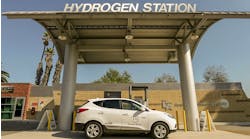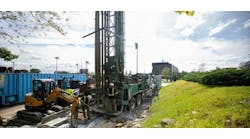In the education community, there is an overwhelming acceptance of global warming. In fact, a number of education organizations have raised calls to action and are assuming leadership roles to reduce greenhouse gas (GHG) emissions and lower their carbon footprints.
For instance, the American College and University Presidents Climate Commitment (ACUPCC) spells out actions that colleges and universities can take to help combat climate warming. More than 500 colleges and universities have signed the ACUPCC. The goal is for signatory campuses to become carbon neutral over time. Many other institutions have made commitments or are being required to meet relevant regulatory requirements.
Improving energy efficiency is the most effective strategy for reducing greenhouse gases, whether or not institutional leaders choose to commit to a formal accord. As Eberhard K. Jochem noted in Scientific American, (September 2006) “ … developing a comprehensive [energy] efficiency strategy is the fastest and cheapest thing we can do to reduce carbon emissions.”
The most effective way to reduce energy consumption is to audit the energy use on a campus and uncover opportunities to improve energy efficiency. This is one step in a successful campuswide energy master plan. Reducing energy consumption in an individual building is helpful, but an energy master plan for an entire campus integrates all facility needs into an even more efficient long-term plan.
Energy master planning in elementary and secondary school districts can provide a cohesive solution for an entire system and pool all of the advantages of having multiple buildings. A master plan can provide a comprehensive maintenance and operating plan, rather than focusing on a single building. Such a plan can reduce maintenance and operating costs by an additional 30 percent.
A thorough campus energy master plan will take into account a campus' past, present and future energy usage. Upon completion, it will evaluate campus, economic and climate benefits and provide approximate costs for carrying out the recommendations.
Step by step
Here is a step-by-step look at the elements of a campus energy master plan:
-
Benchmark existing conditions, and identify funding
Campuses should accumulate data from all significant sources, determine their carbon footprints, establish goals, agree on participants and identify funding opportunities (grants, special budgets or benefactors). Direct energy use for HVAC, lighting and transportation will dominate the footprint.
Needs: Utility bills and emissions data.
-
Building-by-building audit
All buildings must be evaluated and prioritized for excess energy use and current operating needs. Analyze submetered data if available, and consider a plan for installing submeters. The audit should include at least a review of major systems vs. needs. Spot equipment metering and component level analysis also is possible.
Needs: Trained audit engineers are needed for this effort. Consider consultants or state programs.
-
Determine low- or no-cost upgrades
Low- or no-cost efforts can yield 5 to 10 percent energy reduction. These strategies include aggressive occupancy-based shutting or slowing down HVAC equipment, modifying temperature set points and reducing ventilation air to match only what is required for occupants. Restore comfort at pre-agreed times to avoid occupant resistance.
Needs: Scheduling input from building users and system descriptions.
-
Identify retro commissioning opportunities
Mechanical/electrical/plumbing systems in many buildings can lose their efficiency, or in some cases, provide services that no longer are needed. If spaces no longer have lab hoods or cooking equipment, ventilation rates should be reduced. Ensuring that valves and dampers operate as intended (throughout their full range, shutting tight when intended) often can create savings and improve comfort. Studies show that retro commissioning pays for itself within nine months.
Needs: Retro commissioning via dedicated in-house labor or consultants.
-
Discover retrofit opportunities
In many cases, newer technologies can be applied to existing systems, greatly improving efficiency. Lighting-efficiency upgrades, variable speed drives, CO2 sensors, natural cooling cycles and control enhancements normally make good financial sense when applied correctly. Perform economic evaluation or upgrades to determine payback.
Needs: History of energy-efficiency upgrades and plans for future maintenance and equipment replacement, and information on energy-efficiency incentive programs.
-
Optimize new design and major renovation potential
For every construction or renovation project, set a new standard for sustainability and lower energy consumption. Use computerized modeling to optimize site orientation, building glazing and insulation, lighting, HVAC system selection and occupancy-based controls. Evaluate application of heat recovery and dedicated outdoor-air systems, and commission all construction to make sure that all energy and comfort systems are working as intended before the engineers and contractors lose interest.
Needs: Communicate existing standards and guidelines for major construction projects.
-
Evaluate renewable or alternative energy sources
Evaluate options for future energy sources, striking the right balance between low cost and environmental footprint. Consider buying renewables and systems with a reduced carbon footprint, such as photovoltaics, ground-source heat pumps or cogeneration. Develop an emissions trajectory showing likely results with planned new buildings and varying assumptions on reductions and renewables.
Needs: Environmental data, such as wind and solar, and knowledge of the local renewable-energy market.
-
Procure purchased energy wisely
Beyond using less or producing your own renewable energy, an energy master plan can develop strategies for buying from low-cost and less-polluting sources. Renewable energy credits (RECs) and carbon offsets can help meet GHG reduction goals.
Needs: Specialized expertise from dedicated procurement staff or specialty consultants.
-
Prioritize, summarize and communicate
After you've completed these steps, gather results, establish criteria for evaluation, summarize anticipated outcomes, prioritize action steps, and communicate the process and results. Also, periodically reassess the process for future opportunities.
Needs: Expand on benchmarking. Establish appropriate adjustments for weather conditions and levels of use, in order to regularly assess progress.
-
Assess performance and re-evaluate opportunities
The energy master plan is a process, not an event. Results come from constant attention and continual progress. See what worked well — or what didn't. Track activities and results over time. Communicate and celebrate positive steps. Create and distribute annual reports.
Needs: Persistence. Get new people involved and push the limits constantly.
Reaping the rewards
Administrators can act independently at any institution to help reduce GHG emissions. Positive action does not depend on new buildings or long-range plans. Adjusting and improving existing building systems can save energy and advance the commitment to the ecosystems we share.
Education institutions can benefit from developing a campuswide energy master plan that considers student and teaching populations, campus layout and facility-use requirements. This demands an integrated team of facility design, construction and operations specialists, along with financial and energy-procurement analysts, to identify and achieve savings. K-12 and college campuses, even those spread miles apart, can embrace strategic techniques to reduce energy usage, boost recruitment efforts, and affect students and faculty alike.
With these measures, in the short term, your institution becomes more attractive for prospective students. In the long term, you will instill students and faculty with a lifelong eco-friendly attitude.
Craig, LEED AP, is a senior master planner and principal in Einhorn Yaffee Prescott's Boston office. Kennedy, PE, CEM, is director of EYP Energy Services in the firm's Albany office.
30
Percentage that maintenance and operations costs can be reduced with a campus- or districtwide energy master plan.




